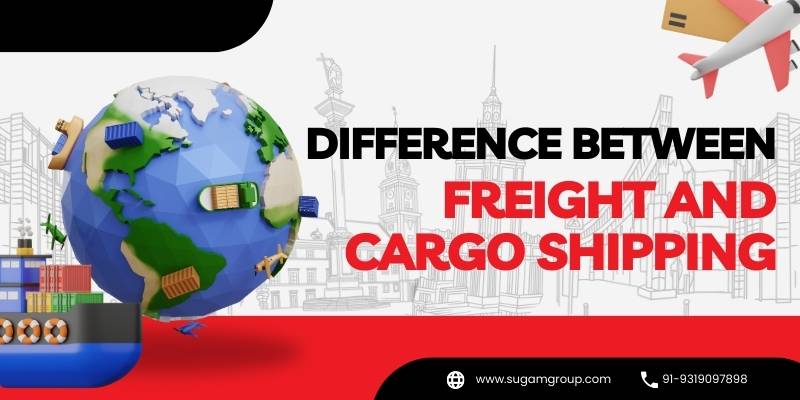Difference Between Freight Shipping And Cargo Shipping
In the dynamic world of logistics and supply chain management, choosing the right shipping method can be the key to success. For businesses like Sugam Group, whose operations span various industries and sectors, the decision between cargo and freight shipping is a critical one. To make informed choices, it’s essential to grasp the fundamental distinctions between these two modes of transportation. In this blog, we’ll delve into the world of cargo and freight shipping, highlighting their differences, advantages, and considerations for businesses like Sugam Group.
What is Cargo Shipping?
Cargo shipping involves the transportation of goods, either in bulk or as individual units. It’s the lifeblood of international trade, moving everything from consumer products to raw materials across oceans and continents. Cargo can take various forms, including dry cargo (such as machinery and electronics), liquid cargo (like petroleum products), and containerized cargo (goods packed in standardised containers). Industries like manufacturing, agriculture, and mining heavily rely on cargo shipping to move their products to global markets.
What is Freight Shipping?
Freight shipping, on the other hand, is a broader term that encompasses the transportation of goods by air, sea, road, or rail. It revolves around the concept of hiring carriers to move goods on behalf of the shipper. Freight transportation offers flexibility and versatility, allowing businesses to choose the most suitable mode of transportation based on their specific needs. Whether it’s the speed of air freight, the cost-effectiveness of sea freight, or the convenience of road and rail freight, this method adapts to a wide range of cargo types and delivery requirements. As per the Organization for Economic Co-operation and Development, there is an expectation that maritime trade volumes will triple by the year 2050 due to the rising demand for global freight.
Cargo vs. Freight – Difference Between Freight and Cargo Shipping
Understanding the difference between cargo and freight shipping is crucial for businesses like Sugam Group. The primary distinction lies in the focus of each method:
1. Type of Goods:
Cargo Shipping: Cargo shipping typically deals with large quantities of standardised goods. These goods may be bulk commodities like coal or grains, or standardised containers filled with various products.
Freight Shipping: Freight shipping is more flexible and accommodates a broader range of goods. Whether it’s perishable goods, fragile electronics, or oversized machinery, freight shipping can handle diverse cargo types.
2. Packaging and Handling
Cargo Shipping: Cargo is often loaded and unloaded in large quantities using specialised equipment, like cranes or conveyor belts. Packaging requirements may be minimal since goods are often transported in bulk.
Freight Shipping: Freight requires careful packaging to protect goods during transit. Fragile items may need extra handling and packaging precautions.
3. Versatility and Flexibility:
Cargo Shipping: Cargo shipping is efficient for transporting large quantities of homogenous goods over long distances. It’s cost-effective for businesses dealing with massive volumes.
Freight Shipping: Freight shipping offers greater flexibility, making it suitable for businesses with varied cargo types, sizes, and delivery timelines. Businesses can choose the mode that best suits their needs.
Considerations for Businesses like Sugam Group
For companies involved in logistics and supply chain management, choosing the right shipping method is not a one-size-fits-all decision. It requires careful consideration of various factors, including cost-effectiveness, delivery times, and the nature of the goods being transported. Here are some essential considerations:
1. Cost-Effectiveness:
Cargo Shipping: It can be cost-effective when transporting large volumes of goods over long distances.
Freight Shipping: Freight provides flexibility, allowing businesses to balance cost-effectiveness with other factors like delivery speed.
2. Delivery Speed:
Cargo Shipping: It may have longer transit times due to the nature of bulk transportation.
Freight Shipping: Freight offers expedited options for time-sensitive deliveries.
3. Packaging Requirements:
Cargo Shipping: Minimal packaging may be required for bulk goods.
Freight Shipping: Proper packaging is essential to protect goods during transit.
4. Cargo Specifics:
Cargo Shipping: Ideal for businesses dealing with large quantities of standardized goods.
Freight Shipping: Suitable for businesses with varied cargo types, including perishables, fragile items, and oversized equipment.
Benefits and Challenges of Freight And Cargo Shipping
Each shipping method comes with its set of advantages and challenges:
Advantages & Challenges of Cargo Shipping:
Advantages of Cargo Shipping:
- Cost-effective for bulk transportation.
- Ideal for industries dealing with homogenous goods.
- Simplified loading and unloading processes.
Challenges of Cargo Shipping:
- Limited versatility for diverse cargo types.
- Longer transit times may not be suitable for time-sensitive shipments.
Advantages & Challenges of Freight Shipping:
Advantages of Freight Shipping:
- Flexibility to accommodate various cargo types.
- Faster transit times for time-sensitive shipments.
- Customizable based on specific business needs.
Challenges of Freight Shipping:
- Potentially higher costs for smaller shipments.
- Requires careful packaging and handling.
Conclusion
As we conclude our exploration of cargo and freight shipping, one thing becomes evident: there is no one-size-fits-all solution. The right choice depends on various factors, including the nature of the goods, cost considerations, and delivery timelines. For businesses like Sugam Group, flexibility is key, and understanding the differences between cargo and freight shipping is the compass that guides them through the seas of logistics, ensuring goods reach their destination efficiently and cost-effectively. So, whether it’s cargo or freight, choose wisely, and set sail towards success in the world of shipping.




No Comments